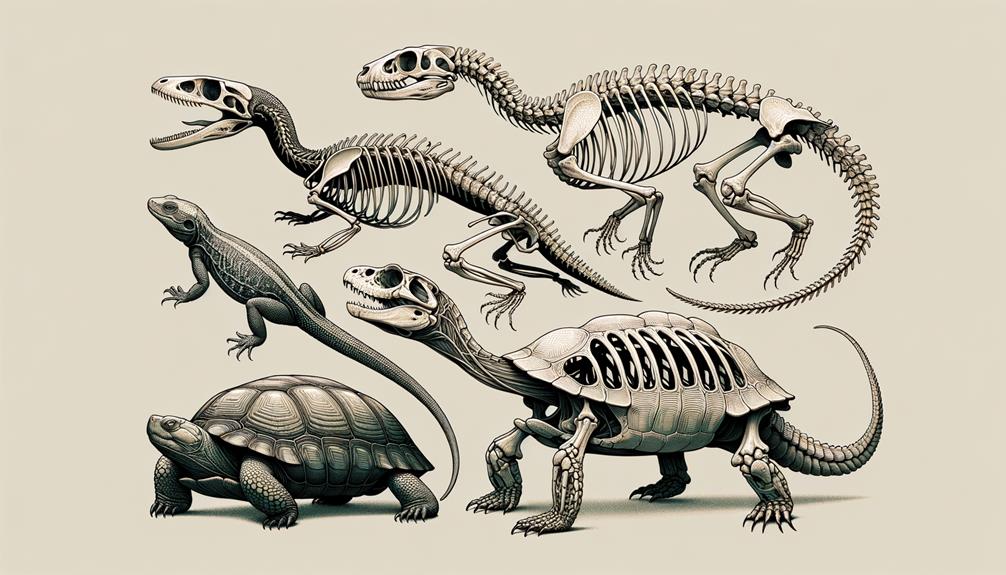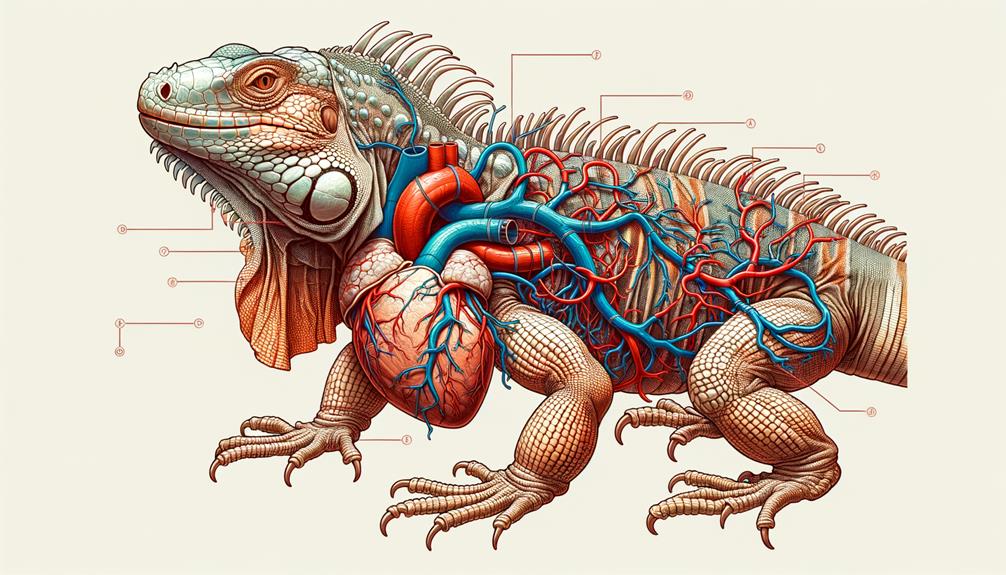I find the reptilian nervous system fascinating. The brain is divided into three main parts: the forebrain, midbrain, and hindbrain. The forebrain handles smell and vision, while the midbrain processes visual and auditory signals. The hindbrain takes care of motor coordination. One of the most impressive aspects of reptiles is their advanced senses. They can see ultraviolet light and have a special organ called the vomeronasal organ that detects pheromones. Some reptiles even have pit organs that can sense infrared heat. The brainstem, which includes the pons and medulla oblongata, regulates critical functions like breathing and heart rate. These adaptations have allowed reptiles to thrive in a wide range of environments. By studying their nervous system, we can gain a deeper understanding of their complex behaviors and unique abilities.
Key Takeaways
<|start_header_id|>
Brain Structure
In examining the reptilian brain's structure, we find a meticulous division into three main regions: the forebrain, midbrain, and hindbrain. Each region is dedicated to specialized functions that are crucial for survival and sensory processing.
The forebrain, responsible for olfaction, houses the cerebral hemispheres, which are more pronounced in reptiles than in fish. This emphasizes the importance of visual and olfactory functions for navigating their environment and finding prey.
The midbrain plays a critical role in processing visual and auditory information, allowing reptiles to react swiftly to their surroundings. The brain stem connects the forebrain and hindbrain, integrating sensory inputs and serving as the control center for basic life functions.
The hindbrain is responsible for motor coordination, receiving input from structures like the lateral line system to fine-tune movements essential for survival. The development of the hindbrain in reptiles is advanced, reflecting their need for precise and agile motion.
In essence, the reptilian brain, with its distinct regions and advanced cerebral cortex, is an intricate design tailored to their ecological niche, providing both freedom and control in their daily lives.
Sensory Processing

As I delve into the world of reptile sensory processing, I want to focus on how their sensory organs function and the neural pathways involved. Reptiles have evolved unique adaptations in their visual, olfactory, mechanosensory, auditory, and thermal systems, each playing a crucial role in their survival and behavior. By examining how these sensory signals are transmitted and processed by their nervous systems, we can gain insight into the complexity of their interactions with their environment.
Sensory Organ Functionality
Reptiles' sensory organs have evolved to process environmental stimuli with remarkable precision and efficiency, directly impacting their heart rate and overall physiological responses.
Many reptiles have highly advanced visual systems that can detect ultraviolet and polarized light, giving them a broader spectrum of visual information. This capability is crucial for navigating their environments and locating prey.
The vomeronasal organ is another significant sensory structure that enhances a reptile's sense of smell. It allows them to detect pheromones and other chemical cues, which is vital for social communication and identifying potential mates or threats.
Aquatic reptiles, such as crocodiles and some turtles, possess a lateral line system that detects water movements. This system enables them to locate prey and predators with remarkable accuracy, even in murky waters.
Some species, including pit vipers and certain boas, have infrared-sensitive pit organs that allow them to detect warm-blooded prey in complete darkness, providing an evolutionary advantage in hunting.
Sensory Organ Adaptations
- Visual Systems: Detect ultraviolet and polarized light for broader visual information.
- Vomeronasal Organ: Enhances sense of smell for detecting pheromones and chemical cues.
- Lateral Line System: Detects water movements for locating prey and predators in aquatic environments.
- Infrared-Sensitive Pit Organs: Detects warm-blooded prey in complete darkness.
Neural Signal Pathways
Neural signal pathways in reptiles allow for precise processing of diverse environmental stimuli, ensuring their survival and adaptation in various habitats. When a reptile detects infrared radiation, specialized receptors convert this information into neural signals that travel through the spinal cord to the brain, where they're processed to detect prey or predators.
In the visual system, light hits the retina, activating rods, cones, and photoreceptors specialized for color vision. This sensory data is transmitted via the optic nerve to the brain's visual cortex, facilitating detailed image formation and color differentiation. The brain interprets these signals, enabling the reptile to navigate and respond to visual cues effectively.
The olfactory system, including the Jacobson's organ, plays a key role in chemical detection. Odor molecules bind to receptors, generating signals that travel through the olfactory bulb to the brain. This pathway is crucial for detecting pheromones, aiding in reproductive behavior and territorial marking.
Lastly, the somatosensory system detects touch, temperature, and proprioception through cutaneous and musculoskeletal receptors. These sensory inputs travel through the spinal cord to the brain, where they're processed, enabling the reptile to react to environmental changes and maintain balance.
Brainstem Functions
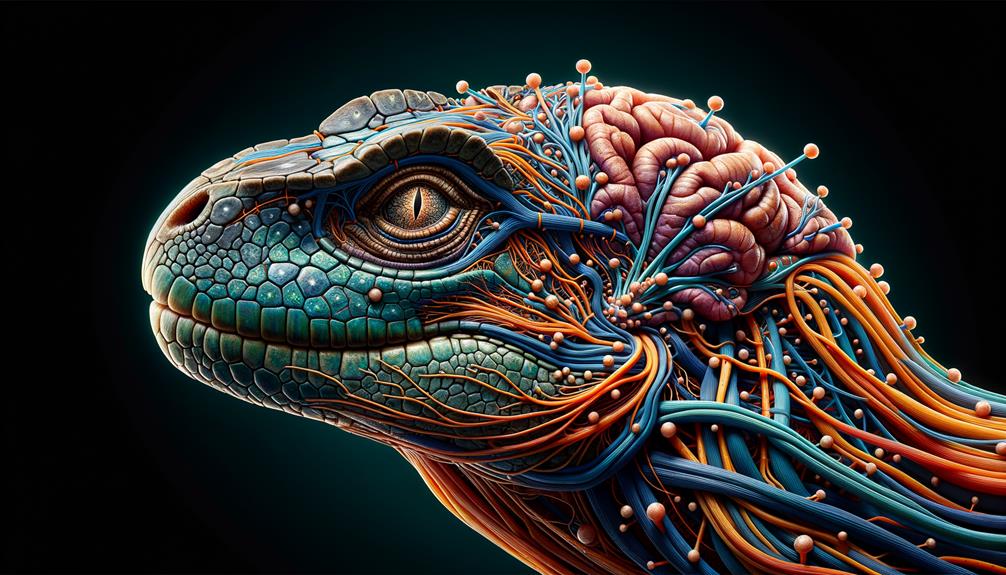
Understanding the brainstem's functions is crucial for appreciating how reptiles manage fundamental physiological processes and respond to their environment. The brainstem, the oldest part of the reptilian brain, is responsible for motor control and autonomic functions. It consists of three main regions: the medulla oblongata, the pons, and the midbrain, though we won't explore the midbrain here.
The medulla oblongata regulates involuntary functions critical for survival, such as breathing, heart rate, and blood pressure. This region serves as the critical connection between the spinal cord and higher brain regions, ensuring seamless communication.
The pons acts as a sensory information relay station, passing data between the forebrain and cerebellum. This function is vital for maintaining balance and coordinating the positioning of the head and body, essential for reptiles' motor control.
Key functions of the brainstem include:
- Regulating respiration and cardiac activity
- Maintaining balance and body positioning
- Relaying sensory information
- Controlling involuntary functions like blood pressure
Midbrain Roles
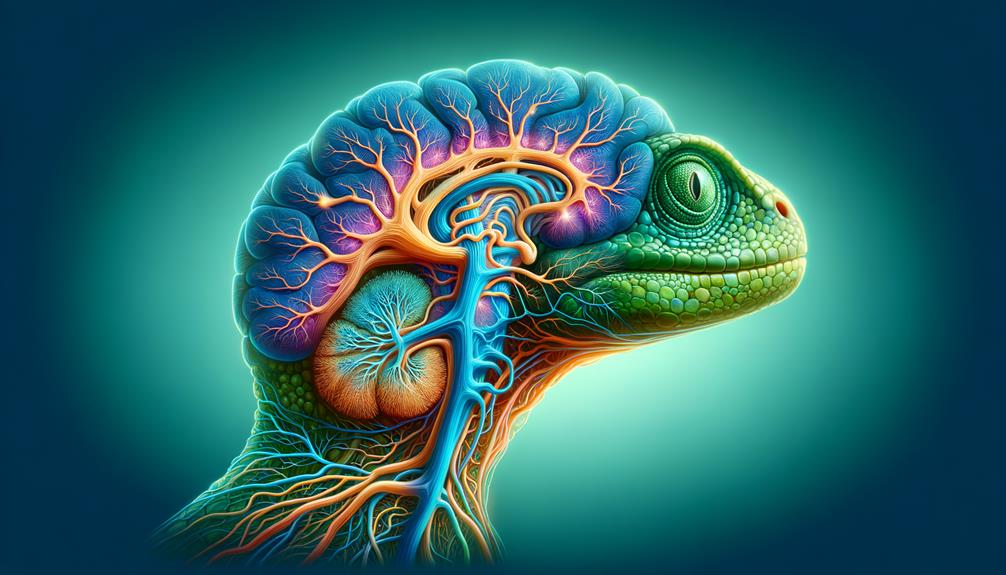
In exploring the midbrain's roles, it's clear that this part of the brain plays a critical role in processing sensory information, particularly when it comes to hearing and staying alert. The midbrain, the widest and most superior segment of the brainstem, acts as a key relay station for sensory data. This gray and white mass, located between the third and fourth brain chambers, efficiently channels auditory signals and regulates the sleep/wake cycles, ensuring reptiles stay responsive to their environment.
The midbrain's role goes beyond just relaying sensory information; it's closely linked with the basal ganglia and limbic system. The basal ganglia, which controls motor function, and the limbic system, which is key to emotion and memory, both interact with the midbrain to influence a reptile's behavior. This interconnectedness means that any impairment in the midbrain can disrupt these critical systems, affecting a reptile's ability to move and respond emotionally.
Interestingly, the midbrain starts developing during the embryonic stage, and high stress levels in utero can impact its formation. Understanding this relationship highlights the importance of a stable developmental environment to ensure proper midbrain function, which in turn safeguards a reptile's sensory processing and alertness mechanisms.
Pons and Medulla
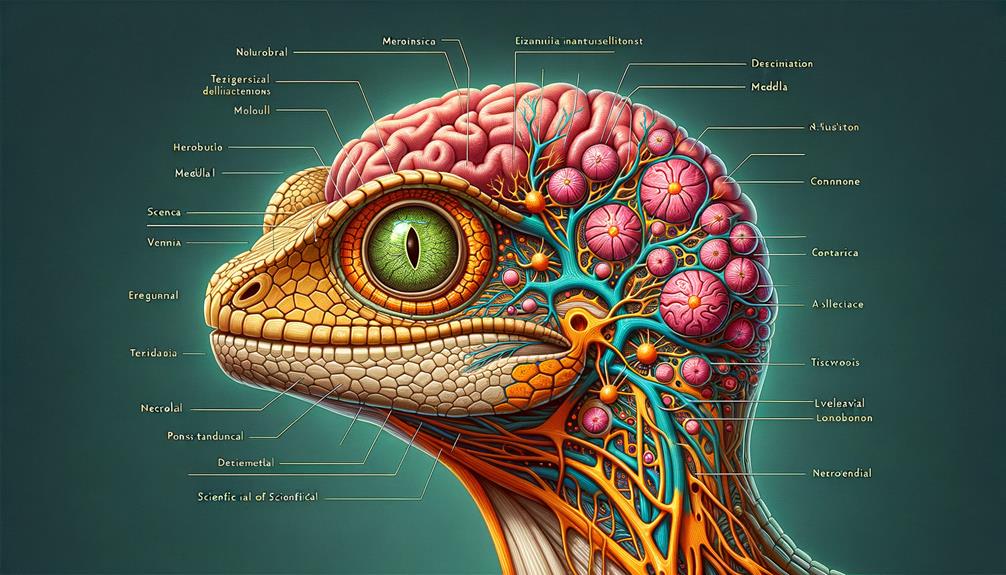
Let's explore the pons and medulla oblongata, key components in the reptile brainstem. The pons acts as a central hub for processing sensory signals, while the medulla oblongata controls vital functions like breathing and heart rate. Understanding these structures helps us see how reptiles manage critical automatic functions and process sensory information.
Respiratory Control Functions
The intricate interplay between the pons and medulla oblongata in the brainstem precisely regulates the respiratory functions essential for survival in reptiles. The pons, with its pneumotaxic center, fine-tunes the breathing rate and depth, ensuring they match the reptile's needs. Meanwhile, the medulla oblongata, housing both the dorsal and ventral respiratory groups, directly controls the rate and strength of each breath.
The pneumotaxic center, located in the pons, adjusts the timing of breathing cycles, preventing over-inflation of the lungs. The dorsal respiratory group, found in the medulla oblongata, primarily handles the initiation of inhalation. The ventral respiratory group, also in the medulla, takes charge during more strenuous breathing, such as during physical activity or stress. Both regions play a critical role in guaranteeing reptiles can adapt their respiratory efforts to varying environmental conditions, such as oxygen deprivation.
Damage to either the pons or medulla oblongata can lead to severe, life-threatening breathing issues. Reptiles heavily rely on these brainstem centers to maintain proper oxygenation, especially during periods of environmental stress.
Cardiovascular Regulation Mechanisms
The brainstem plays a vital role in regulating cardiovascular function, with the pons and medulla oblongata working together to control heart rate, blood pressure, and overall circulatory stability. This regulatory function is essential for all vertebrates, highlighting its fundamental importance.
The medulla oblongata contains three key control centers: the vasomotor center, the cardiac center, and the respiratory center. These centers work together to maintain cardiovascular homeostasis. The vasomotor center adjusts blood vessel diameter, directly influencing blood pressure. The cardiac center, on the other hand, modulates heart rate and force of contraction. Both centers receive sensory information from baroreceptors and chemoreceptors, enabling rapid and precise responses to physiological changes.
Dysfunction or lesions in these areas can lead to severe disruptions, emphasizing their critical nature. In the pons, neuromodulators like serotonin and norepinephrine fine-tune these processes by acting on receptors within these nuclei, optimizing cardiovascular function. The intricate networks of the pons and medulla form a sophisticated system that underpins the stability and adaptability of the cardiovascular system, ensuring survival and well-being across all vertebrate species.
Sensory Signal Processing
Acting as crucial links in sensory signal processing, the pons and medulla oblongata play vital roles in transmitting and interpreting various sensory inputs. This ensures precise communication between the peripheral and central nervous systems. The pons operates as a relay station, passing sensory information seamlessly between the forebrain and cerebellum. It efficiently processes sensations such as hearing, taste, touch, pain, and facial sensations, integrating these sensory inputs effectively.
The medulla oblongata connects the spinal cord to higher brain regions, managing involuntary functions like breathing, blood pressure, and heart rate. It is also the source of critical reflexes such as coughing, vomiting, sneezing, and swallowing. The brainstem, encompassing both the pons and medulla, plays a fundamental role in regulating alertness, body functions, and sensory-motor controls, essential for emotional and behavioral processing.
- Pons: Relays sensory data between the forebrain and cerebellum.
- Medulla oblongata: Controls vital involuntary functions.
- Sensory Integration: Processes hearing, taste, touch, and pain.
- Reflex Control: Manages coughing, vomiting, and sneezing reflexes.
Understanding these components in reptiles provides valuable insights into their unique sensory processing mechanisms, distinct from the neocortex in mammals yet equally intricate.
Evolutionary Adaptations
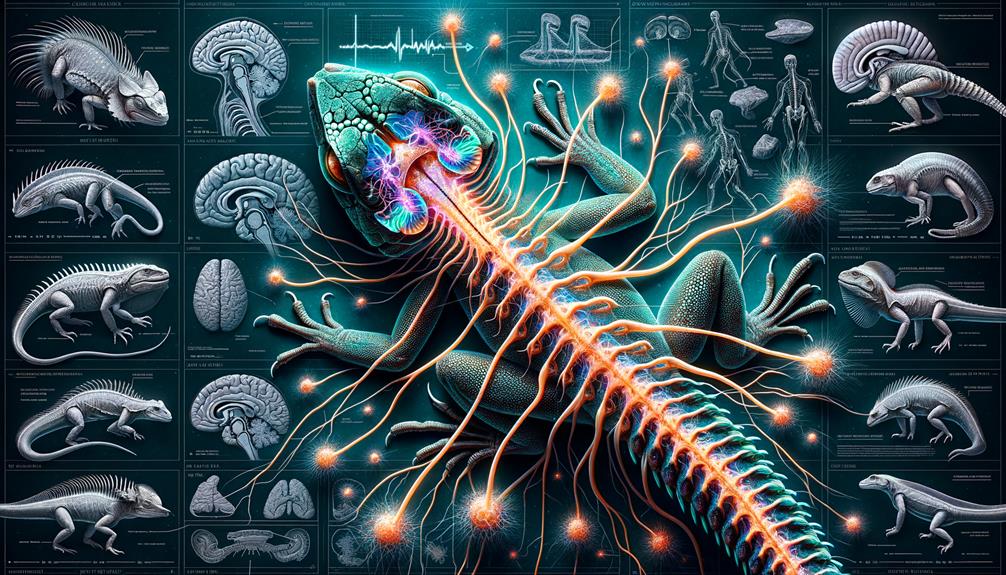
In exploring the evolutionary adaptations of reptilian nervous systems, I find it fascinating how these creatures have developed unique mechanisms to thrive as ectotherms. For instance, they can reduce their metabolic rates during hibernation and mitigate free-radical damage under anoxic conditions. These adaptations enable reptiles to survive in diverse and often extreme environments.
Studies reveal three main areas where reptilian and mammalian neural circuits show remarkable similarities, suggesting a common ancestor. Despite differences in brain complexity, the shared circuit motifs imply that fundamental principles of information processing have been conserved throughout vertebrate evolution. Turtles, for example, can navigate using magnetic, olfactory, and visual cues, showcasing their neural sophistication.
| Reptilian Adaptations | Description |
|---|---|
| Metabolic Rate Reduction | Low energy needs during hibernation |
| Free-Radical Mitigation | Protection against cellular damage in low oxygen |
| Neural Circuit Similarities | Shared motifs with mammals |
| Navigation Abilities | Use of magnetic, olfactory, and visual cues |
| Parental Care & Social Behavior | Displayed in some reptilian species |
The relatively simpler structure of reptilian brains compared to mammals makes them valuable for studying fundamental neurobiological principles. Similarities in developmental bauplan and transcriptomes point to a common evolutionary origin of the vertebrate pallium, underscoring the deep evolutionary connections within vertebrates.
Frequently Asked Questions
What Animal Has the Most Advanced Nervous System?
In my opinion, humans boast the most advanced nervous system, characterized by a highly developed cerebral cortex, complex cognitive abilities, and unparalleled language skills. No other species comes close to our sophisticated neural architecture and intellectual capabilities.
Is the Nervous System Intricate?
The nervous system is incredibly intricate. It's a complex web of neurons, synapses, and circuits that enables everything from basic reflexes to advanced cognitive functions, allowing us to function independently and adapt to our surroundings.
How Is the Nervous System of a Reptile Different From a Mammal?
The nervous system of a reptile is distinct from that of a mammal. One key difference lies in the cerebral cortex, which is less complex in reptiles. Additionally, their limbic system is simpler. Reptiles tend to rely more heavily on instinct, whereas mammals exhibit higher cognitive functions and emotional responses.
Do Reptiles Have an Autonomic Nervous System?
Reptiles do have an autonomic nervous system, which controls involuntary functions like heart rate, digestion, and respiration. Like mammals, it's divided into sympathetic and parasympathetic divisions, ensuring their body's internal balance is maintained.


